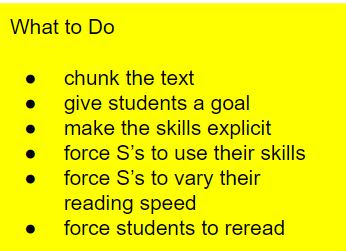Summary Writing
Reading and summary writing may not be the best way to assess comprehension but it is a vehicle for ensuring students focus on their use of comprehension strategies. On a weekly basis students a given a new text to read, to comprehend and to summarise. The rubric below is not comprehensive but it offers a way for students to monitor their own progress. Students get competitive with themselves and with each other. There is no demand for students to share their results but they regularly ask, why is my summary still judged at a Level 3? Why does she have a Level 4 and I’m still achieving at Level 3?
Many of our students find it difficult to write a summary. The rubric has a few flaws in that it has a few negative statements or criteria. So it is not a true indication of Curriculum Levels but it does discourage students from copying sections of the text. Many students avoid risks and persuading them to use real names and place names is a major step forward.
Step 1
Discuss the context of the text and the vocabulary that may cause a breakdown in comprehension.
Step 2
Discuss train compartments and overnight trains and Harry Potter.
Step 3
Reinforce the idea of train journeys in New Zealand and the rest of the world. Glen Innes versus London.
Step 4
Show the students the text they are about to read. Discuss the title and the illustration.
Students do receive a copy of the text at this stage. The focus is on Scanning. If students are allowed the text at this stage many would put their finger to the page and start mouthing the words.
Step 5
Show students the keyword list. Ask students to read the words. Then take them through the process of retelling the story based only on the keywords. Choral fashion. 'Mrs Melrose was on a train, she was going from London to Glasgow, it was three in the morning, she was cold......' Explain how this ability to summarise a text is a very powerful start to comprehending a text.
Step 6
Ask or show students to sort the Keywords onto the Scanning Sheet. Explain the four features of storytelling, characters, setting etc. One, two skip a few. Tell the students that they have looked at the title, looked at the illustration and scanned or considered the keywords. They should now be able to write a Prediction, "I think this story is going to be about......" Have an informed guess. I lie and tell them, I'm not going to mark it. At least half the class will struggle to complete this strategy. Mature readers often think of this skill as automatic. It's like changing gears on a car we don't have to think when we shift the gear stick. For many of our students, this skill is not automatic it must be taught. For many of our students, this basic comprehension skill is weak and it needs to be strengthened. In the past I often waited until a number of texts had been attempted and hoped this skill would improve.
Instead of waiting and giving oral encouragement (sometimes even pleading) I decided to add or create a think-aloud. What do I do when I scan a text and create a prediction? I decided to make this explicit by asking, what am I doing that the students are not doing? ‘You can do better than, "it's about a fur coat, Sir.”’
Heat, eat, repeat








No comments:
Post a Comment